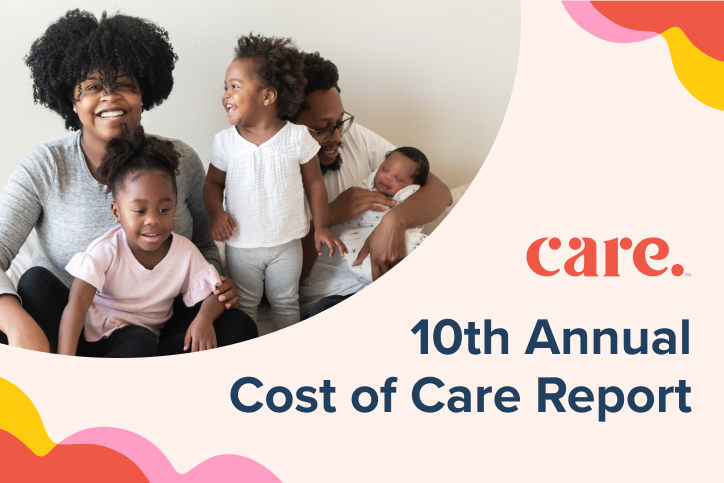Child care is unaffordable for the majority of U.S. families, particularly low-income and middle-class households, according to the Care.com 2023 Cost of Care Report. That’s just one key finding from the 10th annual report, which is based on feedback from 3,000 parents and provides our most thorough look at child care costs yet, including a current-, 5- and 10-year lookback.
For the 10th year in a row, child care costs have continued to rise. Today, families are spending, on average, 27% of their household income on child care expenses. And 59% of parents surveyed tell us they are planning to spend more than $18,000 overall on child care in 2023. It’s no surprise that 50% of parents are more concerned about the cost of child care than they were at this time last year.
“America’s child care crisis is just that: a crisis for the entire country and it impacts us all, whether you have children or not,” said Tim Allen, CEO, Care.com. “Child care is claiming a disproportionate amount of household incomes, and a decade of rising child care costs should be a wakeup call that the system as we know it completely fails the vast majority of families.”
Key findings from the Care.com Cost of Care Report
New data on the cost of child care from the 10th annual Care.com 2023 Cost of Care Report reveals:
Child care is not affordable for most parents
Of parents surveyed, 67% are spending 20% or more of their annual household income on child care (up from 51% in 2022), and 89% spend 10% or more of their annual household income on child care (up from 72% in 2022). Yet according to the U.S. Department of Health and Human Services (HHS), child care is considered affordable when it costs families no more than 7% of their household income.
The cost of daycare is out of reach — and accessibility is a challenge, too
As if the average cost of daycare and being put on a waitlist for daycare isn’t challenging — and expensive — enough, three in four parents (75%) estimate that there are fewer than half a dozen daycare centers within a 20-minute drive of their home.
Care villages are changing
Parents now rely equally on daycare centers and nannies (each 30%) as parents’ top child care arrangements, as compared to last year when daycares were used more frequently (31% vs. 22%). Parents have even more need now for options that provide more flexibility. In fact, 45% of respondents use child care during nontraditional hours, such as 10 a.m. to 1 p.m.
How much does child care cost? (National average)
Here, the average weekly child care costs broken down by type of care for infants:
- Weekly nanny cost: $736 (up 56% from $472 in 2013).
- Weekly daycare cost: $284 (up 53% from $186 in 2013).
- Weekly family care center cost: $229 (up 80% from $127 in 2013).
- Weekly babysitter cost: $179 (up 92% from $93 in 2013)
Top 5 most expensive states for child care
Washington, D.C. ranks as the most expensive state for child care across categories (nanny, babysitter and daycare). After that, these are the other priciest places to live if you’re hiring a nanny, hiring a babysitter or paying for daycare.
Top 5 most expensive states to hire a nanny:
| State | Weekly Nanny Cost |
|---|---|
| Washington D.C. | $885 |
| Massachusetts | $864 |
| California | $849 |
| Washington | $838 |
| Connecticut | $799 |
Top 5 most expensive states to hire a babysitter:
| State | Weekly Babysitter Cost |
|---|---|
| Washington D.C. | $194 |
| Hawaii | $189 |
| Massachusetts | $189 |
| Washington | $188 |
| California | $188 |
Top 5 most expensive states for daycare (infants):
| State | Weekly Daycare Cost |
|---|---|
| Washington D.C. | $417 |
| Massachusetts | $326 |
| Washington | $310 |
| California | $288 |
| Connecticut | $260 |
Nanny costs in the U.S. (Map)
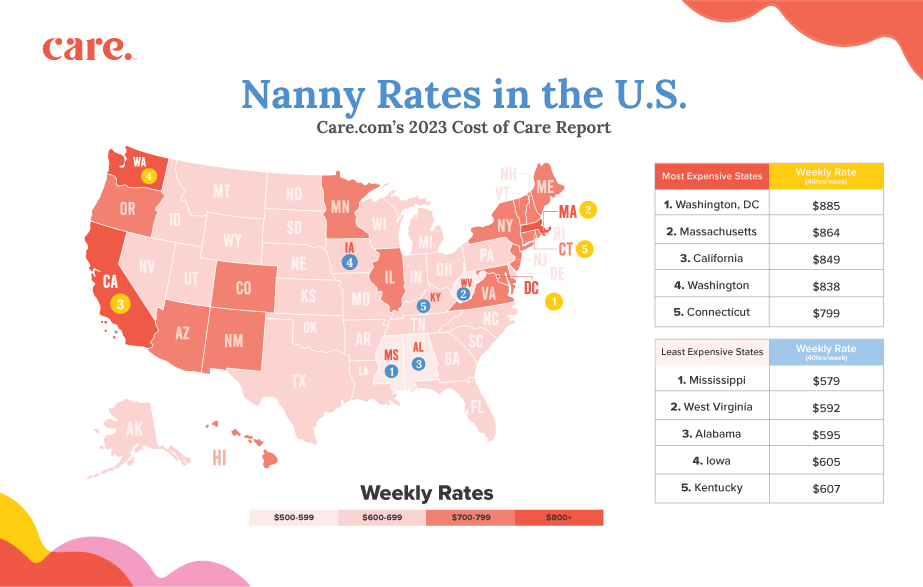
Babysitter costs in the U.S. (Map)
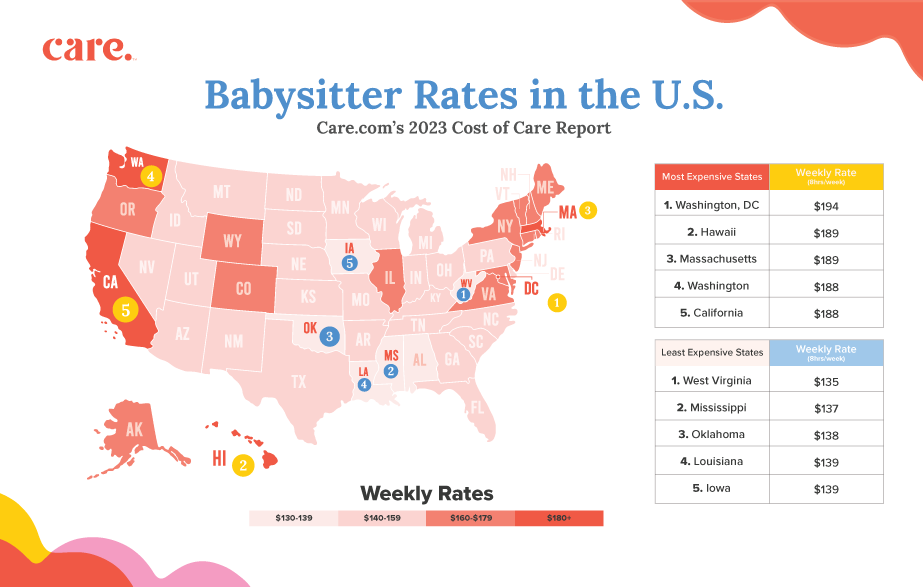
Daycare costs in the U.S. (Map)
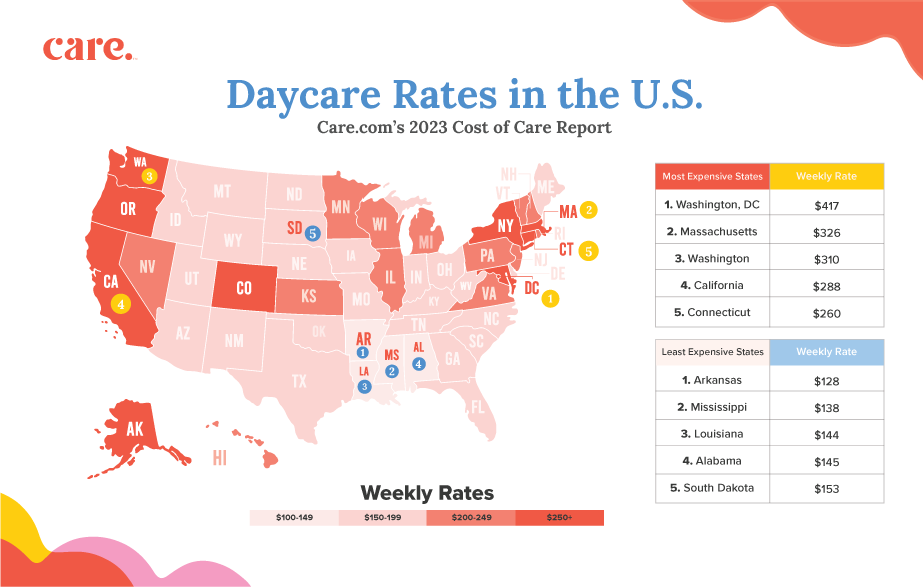
Top 5 least expensive states for child care
The least expensive states for child care include Mississippi (nanny), West Virginia (babysitter) and Arkansas (daycare). Here is what you’ll pay in those states as well as the top five other least expensive places to live if you’re hiring a nanny, hiring a babysitter or paying for daycare.
Top 5 least expensive states to hire a nanny:
| State | Weekly Rate |
|---|---|
| Mississippi | $579 |
| West Virginia | $592 |
| Alabama | $595 |
| Iowa | $605 |
| Kentucky | $607 |
Top 5 least expensive states to hire a babysitter:
| State | Weekly Rate |
|---|---|
| West Virginia | $135 |
| Mississippi | $137 |
| Oklahoma | $138 |
| Louisiana | $139 |
| Iowa | $139 |
Top 5 least expensive states for daycare (infants):
| State | Weekly Rate |
|---|---|
| Arkansas | $128 |
| Mississippi | $138 |
| Louisiana | $144 |
| Alabama | $145 |
| South Dakota | $153 |
How much have child care costs increased in the past decade?
The Care.com 2023 Cost of Care Report took a look at child care costs today compared to five and 10 years ago. To get a sense of how much rates have soared, here are the results:
Infant child care cost per week
| Childcare Type | 2022 | 2018 | 2013 |
|---|---|---|---|
| One child | One child | One child | |
| Nanny Costs | $736 | $619 | $472 |
| Daycare Costs | $284 | $213 | $186 |
| Family Care Center Costs | $229 | $199 | $127 |
Toddler child care cost per week
| 2022 | 2018 | 2013 | 2022 | 2018 | 2013 | |
| One child | One child | One child | Two children | Two children | Two children | |
| Nanny | $701 | $596 | $421 | $726 | $608 | $448 |
| Daycare | $268 | $201 | $153 | $510 | $382 | $291 |
| Family care center | $217 | $201 | $127 | $413 | $382 | $241 |
Babysitter cost per week
| 2022 | 2018 | 2013 | 2022 | 2018 | 2013 | |
| One child | One child | One child | Two children | Two children | Two children | |
| After-School Sitter | $275 | $244 | $181 | $289 | $245 | $194 |
| Babysitter | $179 | $126 | $93 | $176 | $128 | $96 |
– 2013 toddler daycare and family care center rates based off Child Care Aware’s national data for 4-year-old children, due to lack of available data for toddlers.
– All two children rates for daycare and family care centers were calculated by adding the weekly rate for one child and the weekly rate for the second child with a national average sibling discount of 10%.
– All other daycare and family care center rates are based on rate information from centers listed on Care.com.
– Nanny weekly rates account for 40 hours per week and are based on Care.com job post data (full-time care).
– Babysitter weekly rates account for 8 hours per week, are not age limited, and are based on Care.com job post data (one-time and part-time care).
– After-school sitter weekly rates account for 15 hours per week, are not age limited, and account for job posts on Care.com for recurring, after-school hours babysitting.
– Family care centers are defined as daycares operated within the owners’ homes.
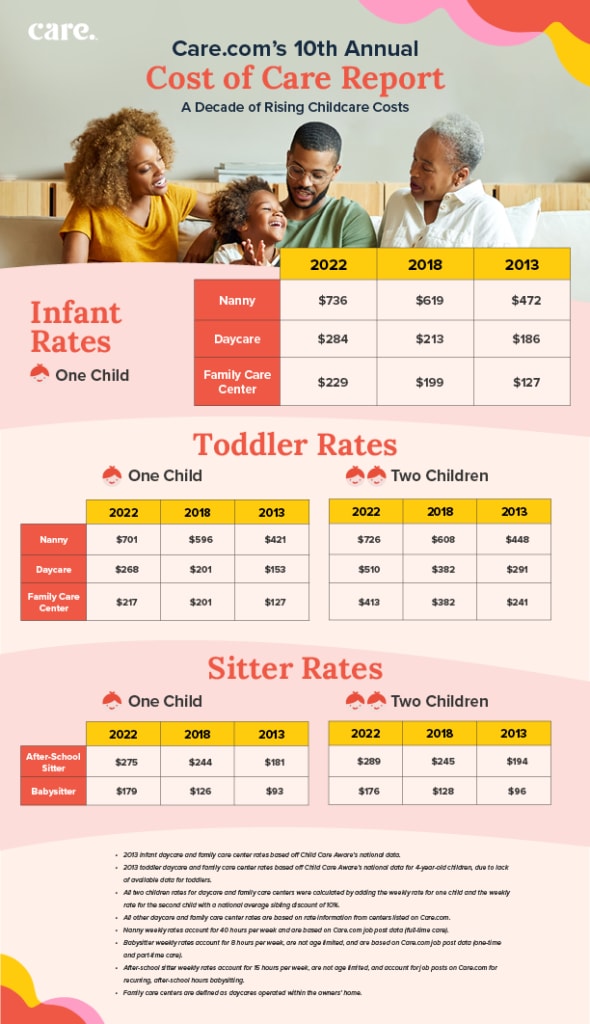
Families are spending much more than what is considered affordable
Households with children make up 40% of the total U.S. population. And with a national family median household income of $91K, child care costs for the typical American family are even more staggering:
- 45% of families earning less than $100K annually will spend more than $18,000 on child care in 2023, amounting to 18% of their household income (HHI).
- 43% of families earning less than $75K will spend more than $18,000, amounting to 24% of their HHI.
- 39% of families earning less than $50K per year will spend more than $18,000, amounting to a whopping 36% of their HHI.
The cost of child care continues to skyrocket
Child care costs will amount to more than $9,600 per child this year, according to the majority of families (79%) surveyed. This is a significant spike from last year’s report, which found 58% planned to spend more than $10K on child care in 2022.
Child care costs near me? Check out our child care cost calculator to estimate hourly child care costs for in-home care in your city.
According to survey data, 58% say child care costs in general are more expensive this year than last year. The reasons parents are paying a heftier bill:
- Child care center fee increases (23%).
- Inflation (18%).
Working parents report that shifting expectations on the job have led to footing a higher bill for care. They attribute paying more to:
- A change in work hours (39%).
- New responsibilities at work (36%).
- A change in work location (32%).
Parents anticipate blowing their child care budget
More than 70% of parents budget for child care costs, but planning won’t necessarily make for smoother sailing.
- One in five (20%) expect to go over budget by the end of year.
- 87% say exceeding their budget would impact household finances.
How accessible is quality child care?
Quality child care feels increasingly evasive for families. In fact, 30% of parents say it’s harder to find child care providers over the past year. In turn, there are a couple of major downstream effects:
Parents are relying on family for child care
Almost half — 42% — lean on relatives for support as part or all of their child care arrangements. These arrangements may be paid or unpaid. And if family isn’t around, parents report falling back on friends (37%) or neighbors (33%).
They’re spending more while waiting for daycare access
For families lucky enough to have access to a daycare center where they live, availability has become the issue for more than half of respondents (64%) who report that they have been put on a waitlist for a daycare center. And 32% of those respondents have been on a waitlist multiple times. Forty-nine percent had to wait more than three months, and of rural parents, 25% waited over a year.
In turn, most (68%) are spending more than $200 per week extra while on the waitlist. Parents most commonly hired a nanny (44%) or had help from relatives (41%) during the waiting period. And single working moms who’ve been waitlisted are hit particularly hard: 73% report paying an additional $200+ per week while on a waitlist and 54% are paying an added $300+.
Families are making big changes to afford quality care
Almost all (90%) of respondents made at least one change to afford child care last year:
- Find a more affordable child care provider (31%).
- Rely on family/friends to help with child care (27%)
- Move closer to family (20%).
- Work multiple jobs (19%).
How are child care costs impacting different families?
Single moms and dads as well as married moms and dads, both hourly and salaried, weighed in on the specifics of their ideal care arrangement, what they’re spending and how they must adjust to make ends meet.
A few key findings:
For single moms, child care costs present unique challenges
Single moms pay a fairly equal share of their household income on child care compared to married couples.
The majority of parents surveyed aren’t using their ideal care arrangement. If both cost and availability were no object, parents would be most likely to choose a nanny (37%) over daycare (35%). However, single moms (both hourly and salaried) use daycare as their top care arrangement and would continue to do so even if money and availability were no object. Nonetheless, 73% have found themselves waitlisted, and 54% have incurred extra expenses upwards of $300 a week or more while on a waitlist.
For all single parents, child care costs require rethinking work
Single parents working hourly jobs are most likely to adjust their work schedules, taking on more or less work, in order to afford or manage child care as compared to other working parents.
- 30% of hourly working single moms reported taking on a second job, and 29% took on multiple jobs last year.
- 27% of single hourly working dads reported reducing hours at work while 25% worked multiple jobs in 2022.
6 ways to save money on child care costs
As the cost of child care continues to rise, consider these steps to make the expense more affordable.
1. Find the best child care for your budget
Once you’re clear on what you can afford, you can steer toward the child care option that’s the best fit for your family. The first step: Research current rates in your area. Care.com has free interactive tools you can use to identify the average costs of nanny and babysitter rates and nanny taxes in your region.
2. Discuss child care benefits with your employer
Parents ranked child care subsidies as the top way employers can provide better child care support (29%), followed by on-site daycare (28%) and backup child care (22%). That said, whether you’re hoping to find backup child or adult care or utilize paid family leave, it can pay to investigate whether or not your employer offers family care benefits. And if they don’t, ask for them.
3. Set aside pre-tax dollars to pay for child care
Talk to your workplace Human Resources department to see if a Dependent Care Account (a type of flexible spending account, or FSA) is available to you and how you can get started. With this account, you can put aside up to $5,000 in pre-tax dollars in your Dependent Care Account to pay for dependent care expenses. (Generally, only one spouse can enroll.)
The savings you will ultimately see varies depending on what your marginal tax rate is. A good approximation is around $2,000 in tax savings, assuming the family uses the full $5,000.
4. Make the most of child care tax credits and tax breaks
Almost all parents surveyed (83%) claimed either the Child Care and Dependent Tax Credit, the Child Tax Credit, or both, to offset child care costs; Among those who didn’t claim the credit, the majority reported lack of awareness was the top reason for not doing so (53%).
By itemizing child-care-related expenses on your federal income return, you could receive a credit on up to $600 of care-related expenses if you have one child, or $1,200 of care-related expenses if you have two or more children.
5. Research child care subsidies and programs
Depending on your income, employee benefits and other factors, your family might qualify for a variety of cost-cutting child care subsidies. We’ve rounded up various programs, resources and other options that could reduce how much you’re paying for care.
6. Advocate for societal shifts
Parents surveyed agreed the big picture changes that would lessen the child care burden include universal preschool, expanded tax credits and a four-day work week.
Child care costs key takeaways
How much are families spending on child care in 2023, on average?
On average, families are spending 27% of their household income on child care expenses. For perspective, this can mean over $18,000 annually for 59% of parents surveyed. This is a significant increase from previous years, reflecting the ongoing rise in child care costs.
What factors are contributing to the rising cost of child care?
Several factors are contributing to the increasing cost of child care. These include inflation, fee increases at child care centers and changes in parents’ work situations. Many parents report changes in work hours, new responsibilities at work and changes in work location as reasons for needing more or different child care.
What strategies are parents using to afford child care?
As child care costs increase, many parents are having to adapt. Some are finding more affordable child care providers or relying on family and friends to help. Others are moving closer to family, working multiple jobs or adjusting their work schedules.
How can parents potentially save money on child care costs?
There are several strategies parents can consider to save money on child care costs. These include researching the best child care options for their budget, discussing child care benefits with their employer, using pre-tax dollars to pay for child care through a Dependent Care Account, taking advantage of child care tax credits and breaks and looking into child care subsidies and programs.
Join Care for free
2023 Cost of Care Report methodology
This sample of 3,000 U.S. adults was surveyed on April 25, 2023 and April 27, 2023. All respondents are parents of children 14 years or younger and currently pay for professional child care, confirmed by both consumer-matched data and self-confirmation. Audience quotas were set to obtain a statistically significant sample of customized geographic regions. DKC Analytics conducted and analyzed this survey with a sample procured using the Pollfish survey delivery platform, which delivers online surveys globally through mobile apps and the mobile web along with the desktop web. No post-stratification has been applied to the results.
Weekly rates for nanny, babysitter and after-school sitter are based on 2022 advertised rates on Care.com. All daycare and family center rates are based on rate information from centers listed on Care.com, except for 2013 rates, where daycare and family care center rates for infants and toddlers are based on Child Care Aware’s national data.
Previous Care.com Cost of Care reports
- The Care.com Cost of Child Care Survey: 2022 Report
- The Care.com Cost of Child Care Survey: 2021 Report
- The Care.com Cost of Child Care and COVID-19 Child Care Surveys: 2020 Report
- The Care.com Cost of Child Care Survey: 2019 Report
- The Care.com Cost of Child Care Survey: 2018 Report
- The Care.com Cost of Child Care Survey: 2017 Report
- The Care.com Cost of Child Care Survey: 2016 Report
- The Care.com Cost of Child Care Survey: 2015 Report
- The Care.com Cost of Child Care Survey: 2014 Report
